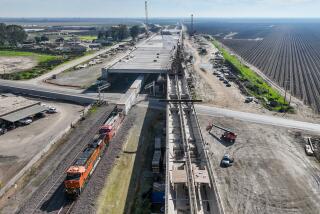Don’t give up on the bullet train, California
Who doesn’t love a train? Who cannot fail to be seduced by the most appealing vehicle in human history — the rail-induced sensuality of “Brief Encounter,” the desperate heroism of engineer Casey Jones, the creative muscle of the Big Four railroad barons, the plucky fortitude of Thomas the Tank Engine and the Little Engine That Could, all wrapped up in gleaming, rocking steel, punctuated by a high, lonesome whistle?
And yet California voters have been expressing morning-after regrets since they voted for Proposition 1A, which promised them a bullet train from Los Angeles to San Francisco. Backers said a Concorde-like fuselage would rocket us to the Bay Area in 21/2 hours and for the low, low fare of $55. A Disneyland ride for grown-ups! And did we mention that it’s carbon-friendly?
The reality has proved more problematic. The California High-Speed Rail Authority stumbled first by promising a smooth construction schedule and a $32-billion price tag. The ensuing lawsuits and engineering revisions have fouled up the timeline and bumped up the price to the current reckoning of $67.6 billion (and it’ll probably be more expensive than that). The rail authority’s latest business plan assumes ever more riders and ever less revenue but still suggests the project will ultimately be self-sustaining.
Unfortunately, surveys demonstrate that voters are at best skeptical. Up to 59% in a late 2012 USC Dornsife/Los Angeles Times poll said they would turn down high-speed rail, given the chance at a redo.
And yet lessons from around the world provide some hope that this romance can be saved. High-speed rail systems generally cost far more than was promised, take longer to build than is logical, have multiple construction headaches and require tempestuous adjustments along the way. But once all the drama is over and the engines are keyed, high-speed trains mostly do outstanding work.
California too may be able to weather the squabbling, get back to the honeymoon and finally to some real-world blessings, if it can backtrack from the following mistakes, many of which were also made by its international predecessors:
Too many stops. There are a raft of complaints about the planned California route, but the Central Valley, now the nation’s busiest short-haul air corridor, is the right place for high-speed rail technology. However, most passengers will want the fastest end-to-end trip possible. France’s TGV embarrassed itself with the Haute-Picard station, built to encourage development in a rural area. The “beetroot” station remains in the middle of the sticks. The builders of Spain’s AVE blemished their network with a stop at a de-populated town called Yebes.
The desire to appease local politicians may be overwhelming, but California’s current 11-stop road from Los Angeles to San Francisco map routed through Fresno is too jerky and slow. The so-called Grapevine route, roughly paralleling Interstate 5 and without as many constituencies to appease, should be resurrected.
Stop pretending it will pay for itself. The hard truth is that high-speed rail almost never makes money. Only two lines of the 99 now operating in the world, Tokyo-Osaka and Paris-Lyon, make any money. And they too required considerable subsidies at the beginning.
In any event, the cost-benefit analysis has to include more than the immediate bottom line: fewer cars on the road, fewer jets in the skies, less pollution in the air.
Bad compromises. Rightfully wary of the affluent and lawsuit-happy residents of the peninsula south of San Francisco, state officials proposed in 2012 to run the bullet train there on existing tracks owned by Union Pacific. This eliminates the need to condemn land and build expensive new tracks, but it also creates hassles with Union Pacific, forces a drastic reduction in speed (which violates the legal mandate to create a 160-minute ride) and heightens the chances of a collision with an automobile at a grade crossing. The “blended” portions of France’s high-speed train are the most frustrating sections for riders and dispatchers. Speed and safety shouldn’t be compromised, even if it costs more.
Not enough Mussolini. This is an unattractive lesson: Big trains like this get built with an autocratic touch. Japan’s Shinkansen train went online in 1964 after enormous domestic resistance only because of the bluster and persistence of an all-but-forgotten bureaucrat named Shinji Sogo, nicknamed Old Man Thunder by his underlings.
So far in California, the high-speed rail authority has hemmed and hawed more than blustered. It planned for an early groundbreaking, to create a physical reality that would be hard to stop, but that’s been a no go. Gov. Jerry Brown’s two-fisted support for the bullet train, and his idea of diverting carbon cap-and-trade revenue for high-speed rail, is the kind of sharp-elbowed move that may be the only way a project like this could ever get built.
The biggest persistence question is this: Will there be U.S. presidents for the next 15 years who, like Obama, will keep stimulus money flowing for the project, even through flying flak?
Californians who want high-speed rail should not lose hope. When the drama of the construction has faded, the end result in almost every nation has been a train that is popular with the public, stuffed with plenty of passengers and genuinely inspiring and useful, even if it doesn’t always pay for itself with fare-box revenue. The honeyed words of the initial promotion may have been written by moonlight, but it doesn’t have to mean a breakup in the cold light of day.
Tom Zoellner, an associate professor of English at Chapman University, is the author of “Train: Riding the Rails that Created the Modern World, From the Trans-Siberian to the Southwest Chief.”
More to Read
A cure for the common opinion
Get thought-provoking perspectives with our weekly newsletter.
You may occasionally receive promotional content from the Los Angeles Times.










